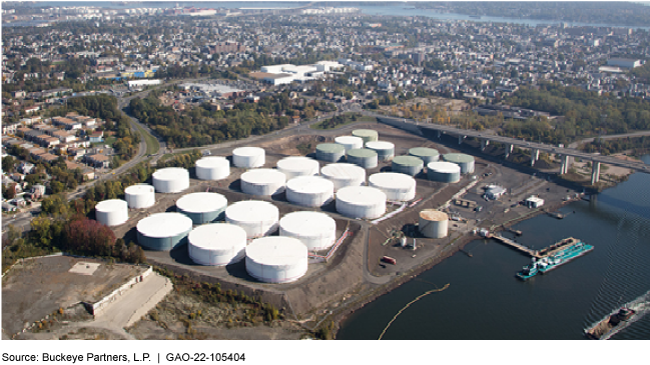Energy Resilience: DOE's Northeast Petroleum Product Reserves
Fast Facts
The Department of Energy holds 2 million barrels of heating oil and gasoline in commercial storage facilities across the Northeast. These reserves were established to reduce the impact of severe supply disruptions in the region.
We found the current reserves are not well suited to this task. They have only been used once to date, after Hurricane Sandy in 2012, and hold less than 2 days' worth of consumption in the Northeast.
We also found that DOE has not fully considered future risks or the benefits of alternatives to the current reserves.

Highlights
What GAO Found
The Department of Energy's (DOE) two petroleum product reserves as currently structured—holding 2 million barrels of heating oil and gasoline in commercial terminals across the Northeast—are not well suited to address the risks of supply disruptions in the region.
GAO assessed DOE's 2020 analysis of the Northeast Home Heating Oil Reserve (NEHHOR) and Northeast Gasoline Supply Reserve (NGSR) and concurred that, among other things, the reserves have only been used once to date and are small relative to regional consumption.
- NEHHOR was used following Hurricane Sandy in 2012 to provide fuel for first responder vehicles. The product reserves' limited use stems, in part, from limitations to releasing petroleum product quickly enough to address short-term disruptions, according to DOE officials (e.g., the requirement to sell the fuel through a competitive process).
- The product reserves are also quite small compared to consumption. Each product reserve contains 1 million barrels of fuel, less than 2 days of consumption in the Northeast. For comparison, DOE also maintains a reserve of 565 million barrels of crude oil, which is more than 30 days of national crude oil consumption.
GAO identified other concerns with the product reserves' effectiveness. For example, NEHHOR and NGSR supplies are commingled in tanks with commercial supplies and, therefore, are subject to the same risks. If a storm disrupts the 5 million barrels of commercial supplies at the Raritan Bay facility in New Jersey, it would likely also disrupt the 0.7 million barrels of gasoline held there for NGSR (see fig.).
Storage Tanks Holding Northeast Gasoline Supply Reserve and Commercial Supplies in New Jersey

DOE has not fully considered future risks to regional petroleum product supplies or the benefits of alternatives to the existing product reserves to mitigate such risks. For example, supply risks in the Northeast and other regions may have changed since NEHHOR and NGSR were created. DOE's 2020 analysis focused on past scenarios rather than future risks or the potential role of alternative ways to mitigate them.
Why GAO Did This Study
DOE maintains two regional petroleum product reserves—NEHHOR and NGSR—to reduce the impact of severe supply disruptions in the Northeast. DOE has held these product reserves since 2000 and 2014, respectively.
GAO was asked to review DOE's product reserves. This report examines (1) the effectiveness of the product reserves in mitigating supply risks and (2) the extent to which DOE has considered future risks and benefits of alternative federal actions.
GAO reviewed DOE documents, laws and practices related to the reserves, and prior GAO work; analyzed DOE cost data; and interviewed DOE officials. GAO also reviewed other reports and data on petroleum product markets and interviewed state energy officials.
Recommendations
In 2018, GAO made a recommendation to DOE that, if fully implemented, would inform decisions regarding federal actions to mitigate the risks of regional product supply disruptions (see GAO-18-477). Specifically, in May 2018, GAO recommended that DOE study the potential need for product reserves in all regions identified as vulnerable. DOE disagreed and has no plans to further study product reserves. GAO continues to believe that fully implementing this recommendation would help DOE more fully assess the risks and potential benefits of alternatives to the existing Northeast petroleum product reserves.
